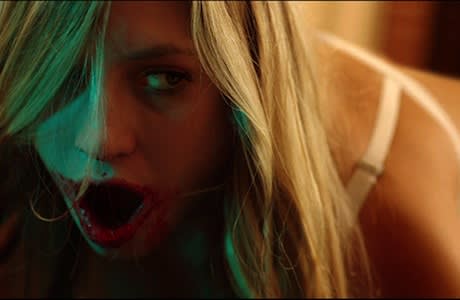Considering the strength of Lucky McKee's previous deceptively astute assaults on fixation and gender roles — May and The Woman — the wildly uneven tone of All Cheerleaders Die suggests that the subversive horror auteur works better alone. A remake of he and I Know Who Killed Me director Chris Sivertson's direct-to-video 2001 flick of the same name, this updated high school horror comedy plays like the crack baby of The Craft and Heathers.
To set the stage, and introduce an element of anxiety that keeps tensions high for the first act, the film starts with a cocky cheerleader breaking her neck during a demonstration being filmed by resident outsider Maddy (Caitlin Stasey). From then on, every flip and jump feels like a risk. The actual acrobatics fade from the picture quickly once the story gets moving though, which is one of the film's biggest strengths and weaknesses: narrative and stylistic corners are turned on a dime.
Offering an exaggerated take on the bitching and backstabbing between friends and cliques in the turbulent hormonal waters of adolescence, Maddy's undercover mission to infiltrate the cheerleading squad, in order to exact vengeance upon one of the jocks, morphs into a supernatural farce.
When Maddy's caricature of an obsessive Wiccan ex-girlfriend enters the picture, it devolves into a sloppy send-up of new age sensibilities. This cheap-shot mockery obfuscates the film's ugly look at a society that fosters a barbaric sense of entitlement in the emotionally stunted via the veneration of athletic superiority. As predatory roles are reversed, this message retains a foothold, but as the bombastic madness continues to intensify, it eventually flounders in the big steaming pile of bat-shit crazy the film becomes.
For a movie ostensibly about how men use positions of power to essentially eat the souls of women, there sure are a number of gratuitous close-up shots of bikini-clad bodies. Superseding any satirical intent on the part of the filmmakers, this objectification, while expected in such an effort, works in opposition to what McKee and Sivertson are trying to say beneath all the chaotic lunacy.
Having as much zany, campy fun as possible is the actual driving motivation of this project, but the humour just doesn't connect often enough to absolve the film's flaws.
(Modernciné)To set the stage, and introduce an element of anxiety that keeps tensions high for the first act, the film starts with a cocky cheerleader breaking her neck during a demonstration being filmed by resident outsider Maddy (Caitlin Stasey). From then on, every flip and jump feels like a risk. The actual acrobatics fade from the picture quickly once the story gets moving though, which is one of the film's biggest strengths and weaknesses: narrative and stylistic corners are turned on a dime.
Offering an exaggerated take on the bitching and backstabbing between friends and cliques in the turbulent hormonal waters of adolescence, Maddy's undercover mission to infiltrate the cheerleading squad, in order to exact vengeance upon one of the jocks, morphs into a supernatural farce.
When Maddy's caricature of an obsessive Wiccan ex-girlfriend enters the picture, it devolves into a sloppy send-up of new age sensibilities. This cheap-shot mockery obfuscates the film's ugly look at a society that fosters a barbaric sense of entitlement in the emotionally stunted via the veneration of athletic superiority. As predatory roles are reversed, this message retains a foothold, but as the bombastic madness continues to intensify, it eventually flounders in the big steaming pile of bat-shit crazy the film becomes.
For a movie ostensibly about how men use positions of power to essentially eat the souls of women, there sure are a number of gratuitous close-up shots of bikini-clad bodies. Superseding any satirical intent on the part of the filmmakers, this objectification, while expected in such an effort, works in opposition to what McKee and Sivertson are trying to say beneath all the chaotic lunacy.
Having as much zany, campy fun as possible is the actual driving motivation of this project, but the humour just doesn't connect often enough to absolve the film's flaws.




